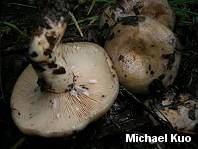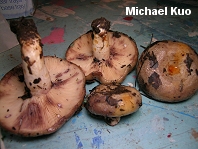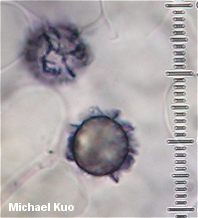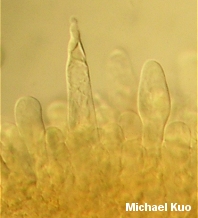| Major Groups > Gilled Mushrooms > Pale-Spored > Lactarius > Lactarius subpalustris |

|
Lactarius subpalustris [ Agaricomycetes > Russulales > Russulaceae > Lactarius . . . ] by Michael Kuo Lactarius subpalustris is an unattractive, messy species from eastern North America, associated primarily with oaks. Its large cap is slimy and drab, its nondescript color ranging from grayish to faintly brownish or yellowish--or maybe just "ish," whatever that might mean. Its milk is copious and white but a little watery, reminiscent of skim milk, and it stains the gills and flesh a dingy lilac color. Under the microscope, Lactarius subpalustris features abundant cystidia and nearly round spores with prominent spines and warts but without an extensive network of connecting ridges. The similar Lactarius maculatus has a conspicuously spotted cap and a strongly acrid taste; it is associated primarily with birch, aspens, and Appalachian pines. Description: Ecology: Mycorrhizal with hardwoods--primarily with oaks but also reported under birch, beech, hornbeam, and ash; growing alone or gregariously; summer and fall; widely distributed in eastern North America. Cap: 5-20 cm; broadly convex with an inrolled margin when young; becoming shallowly depressed, with an uplifted margin, or shallowly vase-shaped; slimy when fresh; bald; drab gray to faintly yellowish or brownish; without concentric zones of color, or with slight hints of zonations. Gills: Beginning to run down the stem; close or nearly distant; creamy white when young, becoming orangish to pale dingy tan; staining and bruising lilac and eventually purplish brown. Stem: 4-10 cm long; 1.5-2.5 cm thick; tough; more or less equal; usually featuring potholes; slimy when very fresh but soon dry; whitish; developing yellowish to brownish discolorations and stains. Flesh: Watery whitish; firm; staining lilac when sliced. Milk: Watery white; staining all surfaces lilac. Odor and Taste: Odor not distinctive; taste mild, bitterish, or faintly acrid (never strongly acrid). Spore Print: Pale yellowish. Chemical Reactions: Cap surface yellow to orangish with KOH. Microscopic Features: Spores 7-11 x 7-9 µ; subglobose to broadly ellipsoid; ornamentation consisting of isolated warts and ridges extending 1-2 µ high, not forming reticula. Pleuromacrocystidia abundant; to about 110 x 20 µ; clavate at first, becoming mucronate to broadly fusiform. Cheilomacrocystidia similar. Pileipellis an ixocutis. REFERENCES: Hesler & Smith, 1979. (Smith, Smith & Weber, 1979; Lewis & McGraw, 1984; Montoya & Bandala, 1996.) Herb. Kuo 09200805. This site contains no information about the edibility or toxicity of mushrooms. |
© MushroomExpert.Com |
|
Cite this page as: Kuo, M. (2011, February). Lactarius subpalustris. Retrieved from the MushroomExpert.Com Web site: http://www.mushroomexpert.com/lactarius_subpalustris.html |



